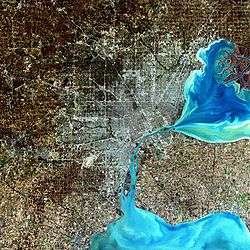Detroit Zoo
 The Horace Rackham Memorial Fountain by Corrado Parducci | |
| Date opened | 1883; August 1, 1928 |
|---|---|
| Location | Royal Oak, Michigan, United States |
| Coordinates | 42°28′37″N 83°09′25″W / 42.47694°N 83.15694°WCoordinates: 42°28′37″N 83°09′25″W / 42.47694°N 83.15694°W |
| Land area | 125 acres (51 ha)[1] |
| Number of animals | 3,300+ |
| Number of species | 280 |
| Annual visitors | 1,476,378 (2015)[2] |
| Memberships | AZA,[3] AAM,[4] WAZA[5] |
| Major exhibits | Amphibiville, Arctic Ring of Life, Australian Outback Adventure, Great Apes of Harambee, Holden Museum of Living Reptiles, Penguinarium, Wilson Free Flight Aviary |
| Website | |
|
Detroit Zoological Park | |
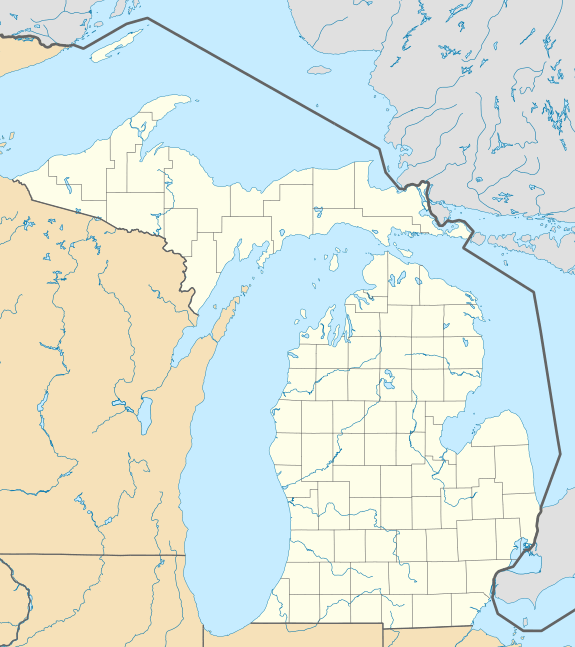  | |
| Location | 8450 W. Ten Mile Rd., Huntington Woods/Royal Oak, Michigan |
| Architectural style | Other, Zoo |
| NRHP Reference # | 90001226[6] |
| Added to NRHP | August 24, 1990 |
The Detroit Zoo is located about 2 miles (3.2 km) north of the Detroit city limits at the intersection of Woodward Avenue, 10 Mile Road, and Interstate 696 in Royal Oak and Huntington Woods, Michigan, United States. The Detroit Zoological Society (DZS), a non-profit organization, operates both the Detroit Zoo and the Belle Isle Nature Zoo, located in the city of Detroit. The Detroit Zoo is one of Michigan's largest family attractions, hosting more than 1.4 million visitors annually.[7][8] Situated on 125 acres of naturalistic exhibits, it provides a natural habitat for more than 3,300 animals representing 280 species.[7] The Detroit Zoo was the first zoo in the United States to use barless exhibits extensively.
History
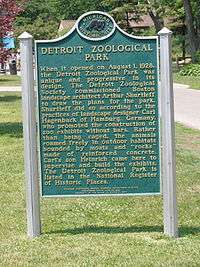
The first Detroit Zoo opened in 1883 on Michigan and Trumbull Avenues, across from the then site of Tiger Stadium. A circus had arrived in town, only to go broke financially. Luther Beecher, a leading Detroit citizen and capitalist, financed the purchase of the circus animals and erected a building for their display called the Detroit Zoological Garden. The zoo closed the following year and the building converted into a horse auction.[9]
The Detroit Zoological Society was founded in 1911, but the zoo's official opening did not occur until August 1, 1928. At the opening ceremony, acting Mayor John C. Nagel was to speak to the gathered crowd. Arriving late, Nagel parked his car behind the bear dens and as he came rushing around the front, Morris, a polar bear, leaped from his moat and stood directly in front of Nagel. Unaware how precarious his situation was, Nagel stuck out his hand and walked toward the polar bear joking, "He's the reception committee." The keepers rushed the bear and forced him back into the moat, leaving the mayor uninjured.[10]
By 1930, the Bear Dens and Sheep Rock had been added, followed shortly by the Bird House. Next to be constructed were the Elk Exhibit, the Baboon Rock, and Primate and Reptile houses. The Detroit Zoo was the first zoo in America with cage-less exhibits.[11]
The onset of the Great Depression brought to a halt additional major projects, but expansion resumed in the 1940s and has periodically continued since then. During the depression, one of the more popular attractions was Jo Mendi, a four-year-old chimpanzee purchased by the zoo director with his own funds. A veteran of Broadway and motion pictures, the chimp performed an act for the audience. As one press account stated, "he enjoys every minute of the act...He counts his fingers, dresses, laces his shoes, straps up his overalls; pours tea and drinks it; eats with a spoon, dances and waves farewell to his admirers." When the chimp fell ill in late 1932 after eating a penny, surgeons from area hospitals came to check him out. During his recovery, visitors brought toys, peanuts and more than $500 worth of flowers, along with several thousands cards and letters. Jo died in 1934 from hoof and mouth disease.[10]
In 1939, sculptor Corrado Parducci created the Horace Rackham Memorial Fountain, popularly known as "the Bear Fountain." The memorial was one of four major donations made by Mary Rackham in the memory of her late husband Horace, the other three being college buildings named after him in Detroit, Ann Arbor and Ypsilanti, Michigan. From the 1950s through the early 1970s, local weatherman Sonny Eliot hosted a television program, At the Zoo, that was shown on Saturdays on television station WDIV.[12]
Until 1982, trained chimpanzees performed for visitors, but the act was discontinued at the insistence of animal rights activists. Also in 1982, the zoo began to charge an admission fee for the first time.[13]
The Arctic Ring of Life, North America's largest polar bear exhibit, opened to the public in 2001.[14][15] The Arctic Ring of Life exhibit is centered on a 300,000 gallon aquarium. The exhibit allows visitors to view the polar bears and seals from a 70-foot (21 m)long underwater tunnel. The tunnel is 12 feet (3.7 m) wide by 8 feet (2.4 m) tall and is made of four-inch (10.1 cm) thick clear acrylic walls that provide a 360-degree view into the aquarium above.[16][17] Other new buildings include the Ruth Roby Glancy Animal Health Complex (opened 2004) and the 38,000-square-foot (3,500 m2) Ford Education Center (opened 2005) which offers school and youth group programs as well as having a theater and exhibit space.

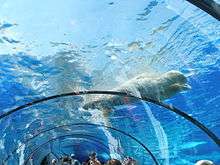
The zoo made additional news in 2005 when it became the first U.S. zoo to give up its elephants on ethical grounds,[18] claiming the Michigan winters were too harsh for the animals and that confining them to the elephant house during cold months was psychologically stressful. The elephants, named Wanda and Winky, were relocated to the Performing Animal Welfare Society's (PAWS) sanctuary in San Andreas, California.[19] The zoo had housed elephants since its opening. Former Detroit Zoo elephant Winky was euthanized in April 2008 at the PAWS sanctuary.[20] The former elephant exhibit was renovated, and is now home to two white rhinoceros, Jasiri and Tamba.[21]
Australian Outback Adventure opened in spring 2006, allowing visitors to walk through a 2-acre (0.81 ha) simulated Outback containing red kangaroos and red-necked wallabies. Nothing separates visitors from the marsupials, allowing the animals to hop freely onto the walking path.[22]
On February 18, 2006, the Detroit City Council voted to shut down the zoo as part of budget cuts, being unable to reach an agreement with the Detroit Zoological Society to take over the park and a legislative grant having expired that day. An uproar ensued and the Council, on March 1, 2006, voted to transfer operations to the Detroit Zoological Society with a promised $4 million grant from the Michigan Legislature. The city retained ownership of the assets, including the Detroit Zoo in Royal Oak and the Belle Isle Nature Zoo in Detroit. The Society is responsible for governance, management and operations, including creating a plan to raise the money needed to keep the facilities operating for generations to come. On August 5, 2008 voters in Macomb, Oakland, and Wayne counties overwhelmingly passed a zoo tax that provides long-term sustainable funding to supplement earned revenue and philanthropic support.
In 2011, the lions received a home makeover, which includes more than double the room to roam, new landscaping and a glass wall for a much closer encounter with visitors. The Detroit Zoo also has the Wild Adventure Ride (simulator), as well as a 3D and "4D" (3D with motion) theater, plus a riding railroad and a carousel. In 2013 the zoo celebrated their single largest donation ever ($10M) by announcing plans for The Polk Penguin Conservation Center (PPCC) which opened in 2016.[23] The PPCC replaces the Penguinarium (which itself was revolutionary when it was built in 1968) and become the largest facility on Earth dedicated to the study of penguins. The Penguinarium is planned to be converted into a Bat Conservation Center since the PPCC has opened.[24]
Mammals
.jpg)
.jpg)
- Matschie's tree-kangaroo
- aardvark
- giant anteater
- ring-tailed lemur
- Japanese macaque
- western lowland gorilla
- drill (animal)
- chimpanzee
- black-tailed prairie dog
- North American river otter
- North American beaver
- Hoffman's two-toed sloth
- Central American agouti
- African lion
- Amur tiger
- black bear
- brown bear
- grizzly bear
- polar bear
- gray seal
- harbor seal
- Arctic fox
- gray wolf
- wolverine
- red panda
- binturong
- miniature donkey
- Przewalski's horse
- Grevy's zebra
- southern white rhinoceros
- warthog
- Bactrian camel
- guanaco
- common eland
- white-lipped deer
- fallow deer
- reticulated giraffe
- American bison
- domestic yak
- Belted Galloway
- domestic horse
- domestic sheep
- pot-bellied pig
- large black pig
- Gloucestershire Old Spots pig
- bush dog
- red kangaroo
- red-necked wallaby
American marten
Because of overharvest for their furs and habitat loss from timber harvest, American martens were extirpated from Michigan's Lower Peninsula (LP) by the early 1900s. In 1986, the United States Forest Service (USFS) and the Michigan Department of Natural Resources (MDNR) reintroduced martens to the Manistee National Forest in the LP.
Wild Yak Conservation
.jpg)
The Detroit Zoological Society has worked to study and conserve wild yak and understand the relationships between domestic yak herders and wild yak on the Tibet/Qinghai plateau of China and the Himalayas of Nepal.
The Detroit Zoo is home to female domestic yak, Novus. She was born in 1999 and arrived at the Zoo a year later. She is described by her keepers as smart and enjoys being groomed. She can be found in the Barn with the belted Galloway steer, miniature donkeys, Thoroughbred horses, pigs and other barnyard animals.
Red panda/snow leopard
The Detroit Zoological Society collaborates with the Xinjiang Institute of Ecology and Geography, the Kunming Institute of Zoology, and the China Exploration & Research Society to study and conserve red pandas, snow leopards and other alpine fauna in China and Nepal. This work uses trail cameras triggered by motion and heat to take pictures of animals and remotely monitor populations of red pandas as well as snow leopards and their prey. Herders are also interviewed to learn more about human-wildlife conflict from snow leopard predation of livestock and to find ways to reduce this conflict.
Grevy's Zebra Trust
.jpg)
The Detroit Zoological Society provides financial support for the Grevy's Zebra Trust (GZT) to help conserve Grevy's zebras. The fates of Grevy's zebra and human livelihoods are inextricably linked to the fragile ecosystem that they inhabit. As a result, GZT works closely with the community rangelands of Kenya and Ethiopia to monitor and protect endangered Grevy's zebras. GZT has education and awareness programs for pastoral children as well as rangeland rehabilitation programs that focus on planned livestock grazing. The success and sustainability of Grevy's zebra conservation is thus critically dependent on having the commitment of communities living across its range. In 2012, GZT was awarded the Association of Zoos & Aquariums (AZA) International Conservation Award.
Gorilla Rehabilitation and Conservation Education
The Detroit Zoological Society has made a major commitment to support the gorilla Rehabilitation and Conservation Education (GRACE) organization in their work to conserve Grauer's gorillas or eastern lowland gorillas. Grauer's gorillas are closely related to the western lowland gorillas at the Detroit Zoo but they are much more endangered. Grauer's gorillas are hunted for their meat and sold as pets and further threatened by the civil unrest in the Democratic Republic of Congo (DRC). GRACE's mission is to provide the best facilities and care for rescued Grauer's gorillas in the DRC while working alongside local communities to ensure gorilla survival in the wild.
Birds
.jpg)
.jpg)
- European white stork
- African spoonbill
- greater flamingo
- Chilean flamingo
- king penguin
- gentoo penguin
- rockhopper penguin
- macaroni penguin
- common peafowl (peacock)
- grey-crowned crane
- Egyptian goose
- spur-winged goose
- mallard
- wood duck
- bald eagle
- Ruppell's vulture
- lappet-faced vulture
- cinereous vulture
- hooded vulture
- Somali ostrich
- greater rhea
- southern screamer
- pink-backed pelican
- barn owl
- domestic fowl (chicken)
- scarlet ibis
- bleeding-heart dove
- jambu fruit dove
- black-naped fruit dove
- boat-billed heron
- Asian fairy-bluebird
- violet turaco
- blue-bellied roller
- taveta golden weaver
- emerald starling
- snowy-crowned robin-chat
- green woodhoopoe
- red-crested cardinal
- sunbittern
- swallow tanager
- blue-gray tanager
- crimson-beaked tanager
- yellow-crowned bishop
- hooded pitta
- red-billed leiothrix
- emerald starling
- pygmy goose
- yellow collared lovebird
- nicobar pigeon
- spur-winged plover
- bare-faced curassow
- green heron
- yellow-vented bulbul
- black crake
- speckled mousebird
- oriole warbler
.jpg)
.jpg)
Trumpeter swan
.jpg)
Trumpeter swans are endangered in the Great Lakes primarily because they are outcompeted by mute swans which were introduced from Europe and are less sensitive to human disturbance. The Detroit Zoological Society (DZS) worked with the Michigan Department of Natural Resources (MDNR) and Michigan State University's Kellogg Biological Station from 1985 to 2006 to reintroduce trumpeter swans to northern Michigan. DZS raised 66 trumpeter swan cygnets at the Detroit Zoo and the former Belle Isle Zoo for release to sites in northern Michigan.
Falklands conservation
The Falklands Islands (Las Malvinas) off the southern coast of Argentina are critical habitat for penguins and contain the largest breeding population of gentoo penguins (about 100,000 breeding pairs). The Detroit Zoological Society has funded the work of Falklands Conservation, an organization which monitors and conducts research on the penguins and other wildlife at several island sites. This research helps to conserve penguin species on exhibit at the Detroit Zoo's Penguinarium and the future Polk Penguin Conservation Center including king penguins, southern rockhopper penguins, gentoo penguins, and macaroni penguins. For example, some of the research uses satellite tracking and geo-locators to identify critical winter feeding areas for king penguins and southern rockhopper penguins.
Center for Penguins as Ocean Sentinels
The Detroit Zoological Society provides funds to support the Center for Penguins as Ocean Sentinels research on Magellanic penguins in Argentina and Galapagos penguins of the Galapagos Islands off the coast of Ecuador. These temperate penguin species – marine sentinels for southern oceans – demonstrate that new challenges are confronting their populations. For example, The Center for Penguins as Ocean Sentinels has demonstrated that Magellanic penguins are swimming 36 miles farther north from their nests during incubation than they did a decade ago. This very likely reflects shifts in prey in response to climate change and reductions in prey abundance caused by commercial fishing. The Center has also shown that increased rain has adversely affected the breeding success of Magellenic penguins. Furthermore, the Center has documented that the Galapagos penguin population has declined by about 75% since 1972 because of variations in the surface temperatures of the eastern Pacific Ocean that are increasing in strength and frequency. The warm temperature cycles are known as El Ninos and they are particularly difficult for Galapagos penguins. The current Galapagos penguin population may be as low as 1,500 individuals making them the rarest of all penguin species.
SANCCOB
To help conserve endangered South African penguins, the Southern African Foundation for the Conservation of Coastal Birds (SANCCOB) collects between 800 and 900 abandoned African penguin chicks and eggs every year for rehabilitation and release back into the wild. Funding from the Detroit Zoological Society has helped SANCCOB construct a nursery to house the larger penguin chicks.
Reptiles

- king cobra
- bushmaster
- Madagascar giant hognose snake
- green tree python
- African spurred tortoise
- Indian star tortoise
- Egyptian tortoise
- veiled chameleon
- emerald tree monitor
- dwarf caiman
- Chinese alligator
- water monitor
- Siamese crocodile
- pig-nosed turtle
- West African gaboon viper
- San Esteban chuckwalla
- rhinoceros ratsnake
- bowsprit tortoise
- Argentine snake-necked turtle
- mata mata
- black iguana
- shingle-backed skink
- pancake tortoise
- beaded lizard
- black speckled palm pitviper
- Uromastyx
- European legless lizard
- Timor python
- big-headed turtle
- Armenian viper
- Mexican lance-headed rattlesnake
- Pacific pond turtle
.jpg)
McCord's Box Turtle SSP
The McCord's box turtle is a critically endangered species from China. McCord's box turtles have been hunted for meat, traditional medicine and a worldwide trade in turtles as pets. These factors, coupled with habitat loss due to the expansion of human populations, have pushed them to the brink of extinction. McCord's box turtles are now rarely seen in Chinese markets, one way of monitoring populations, and this may mean the species is extinct in the wild. The DZS is the manager and studbook keeper for the McCord's Box Turtle SSP to help maintain an assurance population of these turtles in zoos. If protected areas in China can be identified in the future it is hoped that some McCord's box turtles from the HRCC can someday be re-introduced to the wild.
Eastern Massasauga Rattlesnake SSP
Since 2009, the DZS has coordinated the Eastern Massasauga Rattlesnake SSP with Northern Illinois University and several zoos to determine abundance and establish a long-term monitoring program for these rattlesnakes in southwest Michigan. In addition, eastern massasauga rattlesnakes at the HRCC are part of a captive breeding program with partner institutions to build an assurance population. Eastern massasauga rattlesnakes are listed as a species of special concern by the Michigan Department of Natural Resources, and they are protected by state law. The program also includes the development of educational materials about massasauga rattlesnakes for zoos and nature centers in Michigan, Wisconsin, and Ohio to help people understand that massasaugas are not as venomous as other rattlesnakes and in fact provide beneficial services like controlling rodent populations.
Siamese Crocodile SSP

Siamese crocodiles formerly occurred over much of Southeast Asia. However, growing human populations have destroyed much of their habitat, and their current distribution is greatly fragmented. Siamese crocodiles are also threatened by over-hunting, and they are now the world's second most endangered crocodile. As part of the Siamese Crocodile SSP, 11 individuals hatched at the HRCC in 2015 are part of an ongoing reintroduction program to restore and bolster wild populations in protected areas of Southeast Asia.
Aruba Island Rattlesnake SSP
The Aruba island rattlesnake is native to the island of Aruba in the southern Caribbean Sea near Venezuela. Habitat degradation, especially for tourism development, has reduced the Aruba Island rattlesnake population to fewer than approximately 200 individuals in the wild, and it is considered critically endangered. The DZS provides financial support to the Aruba Island Rattlesnake SSP to help restore habitat on Aruba, and as part of the SSP, Aruba rattlesnakes are often housed at the HRCC.
Amphibians
- Puerto Rican crested toad
- Chinese gliding frog
- Panamanian golden frog
- red-eyed tree frog
- yellow and blue poison dart frog
- golden poison dart frog
- Golfodulcean poison dart frog
- three-lined poison dart frog
- green and black poison dart frog
- yellow-banded poison dart frog
- giant Asian toad
- Asian painted toad
- Mexican giant tree frog
- Japanese giant salamander
- eastern red-spotted newt
- Amazon milk frog
- tiger salamander
- emperor newt
- Mississippi gopher frog
- crawfish frog
- Malayan horned frog
- mantella
- mountain chicken frog
- Wyoming toad
- caecilian
.jpg)
Peruvian rainforest frogs
Since 2010, the Detroit Zoological Society has been involved in an assessment of amphibian populations in the Peruvian Amazon. The project includes field surveys to document species living in several sites along the Amazon and Napo rivers and testing for chytridiomycosis (chytrid Bd), an amphibian disease that is wiping out amphibian populations throughout South America and other parts of the world. People living in and around the study sites assist with conducting surveys so they can be a part of conserving their unique and fragile environmental heritage.
Education is also a critical component of this project. Local people around the study sites learn that amphibians are important components of the ecosystem by eating insects and serving as food for other animals and that they are important bio-indicators that reflect the health of the environment. Education about amphibians also dispels myths about amphibians, such as the myth that humans can contract diseases from toads. Changing erroneous and harmful attitudes about animals is a critical step in saving amphibians and other wildlife.
Mississippi (Dusky) Gopher Frog SSP®
Frogs/Toads SSPAs part of the Mississippi (Dusky) Gopher Frog SSP®, the DZS and the NACC maintain an "assurance population" of this critically endangered species. The captive population serves as insurance against extinction until the species can be adequately protected in the wild and suitable locations are found for release. The Mississippi (dusky) gopher frogs are maintained in special bio-secure off-exhibit rooms of the NACC. In fact, more than half of the NACC is off-exhibit with bio-secure or disease free areas for breeding. Closed circuit televisions at the NACC provide a glimpse into this work being done behind the scenes.
Wyoming Toad SSP
As part of the Wyoming Toad SSP®, the DZS breeds critically endangered Wyoming toads at the NACC. Since 2001, the DZS has released more than 6,500 Wyoming toads into the wild as tadpoles, toadlets and adults. This population is maintained in special bio-secure off-exhibit rooms of the NACC. In fact, more than half of the NACC is off-exhibit with bio-secure or disease free areas for breeding. Closed circuit televisions at the NACC provide a glimpse into this work being done behind the scenes. The NACC staff also participates in yearly monitoring of the Wyoming toad population at release sites in Wyoming.
Puerto Rican Crested Toad SSP
As part of the Puerto Rican Crested Toad SSP, the DZS and the NACC breed critically endangered Puerto Rican crested toads. Since 2008 more than 47,000 tadpoles have been released into the wild.
Panamanian Golden Frogs SSP
As part of the Panamanian Golden Frog SSP, the DZS and the NACC maintain an "assurance population" of this critically endangered species. The captive population serves as insurance against extinction until the species can be adequately protected in the wild and suitable locations are found for release
Mudpuppy
Since 2006, the Detroit Zoological Society has monitored mudpuppies in the Detroit River to track and better understand the population size and health of local mudpuppies. The aquatic salamanders are measured, weighed and implanted with computer chips for identification before being returned to the river. The Detroit River's water chemistry is also tested and logged. The data gathered provide a valuable baseline for monitoring the health of the Detroit River ecosystem. Mudpuppies are important environmental watchdogs that visitors to the Detroit Zoo and the Belle Isle Nature Zoo can observe and learn about.
FrogWatch USA
FrogWatch USA is a national citizen science program through the Association of Zoos and Aquariums (AZA) for monitoring local frog and toad populations. The amphibian staff of the Detroit Zoological Society train citizen scientists to collect data about Michigan frogs and toads by identifying their calls. These data are then included in the national AZA database as well as the Michigan Department of Natural Resources herp atlas to help monitor the distribution and population trends for frogs and toads. If you are interested in contributing to frog and toad conservation from your backyard to across Michigan, join the local monitoring team. Training opportunities occur every February and March.
Exhibits
Amphibiville
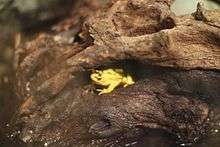
The National Amphibian Conservation Center is a $7 million, 12,000-square-foot facility situated on a two-acre Michigan wetland area and pond called "Amphibiville". The exhibit, which opened in June 2000, boasts a spectacular diversity of frogs, toads, salamanders, newts and caecilians. The Wall Street Journal dubbed the attraction "Disneyland for toads".[25] The National Amphibian Conservation Center participates in research and conservation efforts for species including the Panamanian golden frog, Puerto Rican crested toad, and Wyoming toad.
In addition to amphibian space, the center includes a rainforest immersion room which houses a sloth, Central American agouti, red-footed tortoise, ocellated stingray, mata mata, qand Pterygoplichthys pardalis, all of which roam the exhibit space freely with visitors.
In 2002, the Detroit Zoo was awarded the AZA National Exhibit Award for Amphibiville.[26]
The Arctic Ring of Life

In addition to polar bears, the exhibit is home to grey seal, harbor seal, and Arctic fox with available exhibit space for snowy owl or Arctic hare in Arctic Ring of Life, which opened in October 2001, is North America's largest polar bear exhibit. The $14 million four-acre interactive facility features the Frederick and Barbara Erb Polar Passage, where visitors walk through a 70-foot-long clear underwater tunnel as polar bears and seals may swim around them.
The most unusual feature of the Arctic Ring of Life is the spectacular 70-foot-long Frederick and Barbara Erb Polar Passage, a clear tunnel that winds through a vast underwater marine environment. This 12-foot-wide, 8-foot-tall tunnel takes visitors underneath diving and swimming polar bears and seals. The bears and seals are separated from each other by a transparent barrier but appear to share one aquatic environment. Visitors then arrive in an "ice world", passing through a frigid ice cave and finally entering the Exploration Station with additional indoor viewing.In 2003, the Detroit Zoo was awarded the AZA Significant Achievement Award for the Arctic Ring of Life.[26]
Australian Outback Adventure
.jpg)
The Australian Outback Adventure is home to a mob of 19 kangaroos and their close cousins, the red-necked wallabies. Visitors can get face-to-face with the marsupials from right inside this immersive habitat, traveling along a winding path while the animals are free to bound and graze wherever they please.
Cotton Family Wetlands and Boardwalk
Mimicking a Michigan ecosystem, the 1.7-acre pond and wetlands area and accompanying 7,200-square-foot boardwalk is home to native fish, frogs, turtles and birds as well as the zoo's trumpeter swans. The boardwalk itself is made from a 95-percent recycled wood-alternative decking material called Trex, composed primarily of plastic grocery bags and reclaimed hardwood. The Wetlands and Boardwalk are bounded by Amphibiville, the Warchol Beaver Habitat, the Mardigian River Otter Habitat, and the Holden Reptile Conservation Center.
Thanks to a $102,350 grant from NOAA, the Wetlands are also able to be used as professional development and outdoor classroom for teachers and students underrepresented in science fields.[27]
Cotton Family Wolf Wilderness
.jpg)
The Cotton Family Wolf Wilderness is a $1.4 million two-acre sanctuary that features native meadows and trees, a flowing stream and pond, dens, and elevated rock outcroppings from which two gray wolves survey their surroundings. The exhibit also incorporates a renovated historic log cabin which had existed on the property.[28]
Dinosauria!
Debuting in 1993, Dinosauria! has been an annual summertime attraction including 40 animatronic dinosaurs on three acres. It is the nation's largest animatronic dinosaur exhibit.
Giraffe Encounter
At the Giraffe Encounter, guests are able to feed three giraffes from a balcony pavilion that extends into their habitat. This experience, which started in July 2007, runs daily from spring through fall.
The Great Apes of Harambee
The Great Apes of Harambee is a four-acre indoor/outdoor habitat which houses chimpanzees, western lowland gorillas and drills. The animals may be rotated into each other's exhibit spaces, as this simulates nomadic movement similar to wild behavior.[29]
Holden Reptile Conservation Center
.jpg)
.jpg)
Opened as the Holden Museum of Living Reptiles in 1960, the Holden Reptile Conservation Center is home to 180 reptiles representing 70 species, one-fifth of which are considered threatened or endangered in the wild. Among the species are
- king cobra
- bushmaster
- Madagascar giant hognose snake
- green tree python
- African spurred tortoise
- Indian star tortoise
- Egyptian tortoise
- veiled chameleon
- emerald tree monitor
- dwarf caiman
- Chinese alligator
- water monitor
- Siamese crocodile
- pig-nosed turtle
- West African gaboon viper
- San Esteban chuckwalla
- rhinoceros ratsnake
- bowsprit tortoise
- Argentine snake-necked turtle
- mata mata
- black iguana
- shingle-backed skink
- pancake tortoise
- beaded lizard
- black speckled palm pitviper
- Uromastyx
- European legless lizard
- Timor python
- big-headed turtle
- Armenian viper
- Mexican lance-headed rattlesnake
- Pacific pond turtle
Among the more dramatic features of the center is the habitat of a reticulated python. The centerpiece of the 20-by-8-by-8 foot space is a large stone head deity fashioned after temple idols found at Angkor Wat in Cambodia. The enclosure also features a variety of plants and trees to offer the python the sanctuary it would find in a native habitat as well as a basking pool that provides underwater viewing for visitors.
Mardigian River Otter Habitat
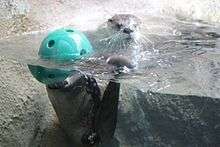
The Edward Mardigian, Sr. River Otter Habitat provides a habitat for five river otters and features an 5,900-gallon pool complete with waterfall and waterslide. The pool is enclosed on one side by a glass wall, on the other side of which is an observation building. The habitat is designed so that small children can view the otters at eye level as they swim.
The habitat is designed so that visitors – including small children – can watch the long-bodied mammals swimming and playing at eye level.
The North American river otter (Lontra canadensis) can weigh 20-30 pounds, and its slender, cylindrical body can reach 2–3 feet in length. The aquatic mammal sports short, dense, waterproof fur and profuse whiskers. The playful river otter is swift on land as well as in the water, though its loping trot can look somewhat ungainly compared to its graceful slide through the water.
In March 2012, the population of three river otters was doubled when mother Whisker, 9, and father Lucius, 6, had three pups, one female and two male. This was the first otter pup birth at the Detroit Zoo in nearly 50 years.[30] Two more male pups were born to the same parents in April 2014.[31]
Penguinarium
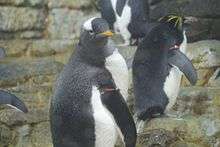
The Penguinarium was the first zoo building in the world designed entirely for penguins. The three-sided habitat includes underwater viewing and is surrounded by a continuous pool which allows the penguins to swim fast enough to porpoise or "fly through the water," a behavior frequently seen in the wild. The Detroit Zoo is one of the few zoos in the world to incorporate this design feature.
The three-sided Penguinarium was renovated in 1985 to incorporate features of the natural environments in which the zoo's three species of penguins occur. The temperature of the air and water is kept between 45 and 50 degrees F. The light cycle is controlled to resemble the natural photoperiod that the birds would experience in the wild which helps regulate molting and breeding behaviors.
The Detroit Zoo houses four species of penguin in the Penguinarium, king, macaroni, and rockhopper. A fourth species, gentoo, was introduced in 2014 in preparation for the move to the Polk Penguin Conservation Center.
Polk Penguin Conservation Center
The Polk Penguin Conservation Center (PPCC), which is scheduled to open in early 2016, is the largest project the Detroit Zoo has ever undertaken. Features of the $30 million facility will include a penguin "deep dive" with views above and below water as the birds are able to dive and porpoise through a chilled 326,000-gallon, 25-foot-deep aquatic area.[32] The PPCC, which is named after the single largest donation ever received by the zoo ($10M),[23] will be the largest facility in the world dedicated to the study of penguins.
Warchol Beaver Habitat
Opened in 2013, the Warchol Beaver Habitat abuts the Cotton Family Wetlands, and is home to two beavers. As beavers are nocturnal, their night-time activities are recorded and played throughout the day on televisions in the exhibit. This is the first time beavers have been on display at the Detroit Zoo since 1969.
A family of three American beavers reside at the Jane and Frank Warchol Beaver Habitat on the northern edge of the Cotton Family Wetlands. Male Ward and female Eve – born in 2011 and 2013, respectively – arrived in 2013, marking the first time the Zoo has had American beavers since 1969. Their kit, Meta, was born in 2015.
The Wildlife Interpretive Gallery
The Wildlife Interpretive Gallery is home to the Butterfly Garden, Wilson Free Flight Aviary, a 90-seat theater, and the zoo's permanent fine art collection.[33]
In addition, a 3D theatre experience called Science on a Sphere is located in the Wildlife Interpretive Gallery. Developed by NOAA, Science On a Sphere is a spherical display system that projects dynamic simulations of the Earth, its atmosphere, oceans, and land using computers and video projectors to display planetary data onto a 6-foot diameter sphere, analogous to a giant animated globe. The Detroit Zoo was the second zoo in the country to implement this exhibit as a permanent attraction.
Butterfly Garden
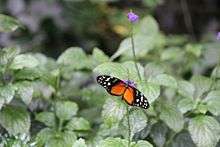
The Butterfly Garden is a tropical indoor habitat featuring hundreds of butterflies from Central and South America. With 25 species represented, the Detroit Zoo purchases roughly 250 pupae weekly from butterfly farmers such that no insects are taken from the wild.
The Detroit Zoo's Wildlife Interpretive Gallery houses hundreds of free-flying butterflies. The Zoo purchases about 250 butterfly pupae (chrysalises) each week from growers in Costa Rica and El Salvador. The butterflies are raised by growers who maintain their own breeding stock; they are not taken from the wild but are part of an effort to promote butterfly conservation programs in those countries. Approximately 25 species can be observed engaging in many of their natural behaviors, including feeding on flower nectar or ripe fruit and basking in the sunlight. The garden is kept at a balmy 75 degrees Fahrenheit, the optimal temperature for the butterflies to take flight. The immersive habitat is open year-round and is free with Zoo admission.
A special behind-the-scenes experience called Breakfast with the Butterflies gives visitors the opportunity to learn about butterflies firsthand. During a continental breakfast, a zookeeper shares the secrets of butterfly watching in the garden and in the wild, followed by the opportunity to prepare chrysalises for display and to release new butterflies in the garden.
Wilson Free Flight Aviary

In the Matilda Wilson Free-Flight Aviary, over 30 species of birds are free to fly, walk, or swim among the cover of lush tropical plants in a warm and inviting climate. Viewing birds in this habitat is a lot like bird watching in the field; you need to be patient and will sometimes only catch a glimpse of the birds. Take your time and walk slowly along the meandering path and look around in all directions, especially up. Birds may be high overhead or hidden among the plants just inches away from you.
The boldest birds share the pathway with visitors while some will only be seen by those with the patience of a seasoned bird watcher. The Free-Flight Aviary is a great spot at the Zoo during the winter when visitors can get a break from the cold weather and find a comfortable area, quietly settle in, and listen to the sounds of the birds as they call to each other. Since the birds are free to go anywhere in the habitat and are often secretive, you will likely see different species on each visit to the Zoo.
Some of the species that can be easily seen are scarlet ibis and bleeding heart doves, named after the red spot of feathers on their chests. But if you look more closely in the tree, you may see a boat-billed heron looking for fish or a tanager feeding on fruit. Masked lovebirds can be heard calling, red-billed leiothrix will dart at eye level looking for insects, and pygmy geese swim in the stream.
Because of the birds’ secretive behavior, the keeper staff uses treats to bring the birds close for observation and censusing. These sessions occur during public hours and are accompanied with a description of the birds’ identification and their behaviors. If you happen to be present when these activities take place feel free to ask questions of the staff; they are always happy to help you enjoy your Zoo experience.
- scarlet ibis
- bleeding-heart dove
- jambu fruit dove
- black-naped fruit dove
- boat-billed heron
- Asian fairy-bluebird
- violet turaco
- blue-bellied roller
- taveta golden weaver
- snowy-crowned robin-chat
- green woodhoopoe
- red-crested cardinal
- sunbittern
- swallow tanager
- hooded pitta
- yellow-collared lovebird
- red-billed leiothrix
- pygmy goose
- nicobar pigeon
- spur-winged plover
- bare-faced curassow
- green heron
- common bulbul
- black crake
- speckled mousebird
- oriole warbler
Sections of the zoo
African Forest
.jpg)
Located near the Arctic Café on the northwest side of the zoo, the African Forest is home to several species of must-see African natives, including the residents of the Great Apes of Harambee – chimpanzees, gorillas and drills – and birds such as crowned cranes, flamingos, spoonbills, and vultures.
African Grasslands
.jpg)
The African Grasslands in the zoo's northwest corner provides an environment for learning about the diverse, adaptable species of the vast African Savannah. Warthogs help tell the story of this important biome, and are joined by the reticulated giraffes, Grevy's zebras, white rhinoceroses, lions, African birds and aardvarks.
Asian Forest
Located on the north side of the zoo near the Red Panda Picnic Site, the Asian Forest is home to red pandas, Amur tigers, Japanese macaques and lion-tailed macaques.
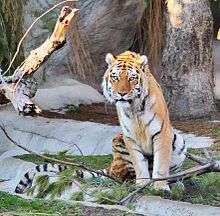
.jpg)
Distantly related to the raccoon, the red panda is a solitary creature found in the mountains of Nepal, Myanmar and Central China. The Amur tiger is the largest of the five remaining subspecies of tigers and the largest member of the cat family. Lion-tailed macaques are an endangered primate found in the rainforest treetops in India. Japanese macaques, also known as snow monkeys, are one of very few species of non-human primates to live in cold-weather climates. They can often be seen basking in the warm steam from the hot tub in their habitat near the lions. The Bactrian camels at the zoo, female Suren and male Rusty (both born in 2008) and their son, Humphrey, born in the spring of 2014, can be seen roaming their habitat across from the Horace H. Rackham Memorial Fountain, along with the Przewalski's horses, white-lipped deer, American elk, and fallow deer.
Australian Outback Adventure
The Australian Outback Adventure is home to a mob of 20 kangaroos and their close cousins, the red-necked wallabies. Visitors can get face-to-face with the marsupials from right inside this immersive habitat, traveling along a winding path while the animals are free to bound and graze wherever they please.
The habitat simulates the Outback experience with coordinated landscaping, plantings, and even three typical Outback settlement buildings, including "Max's Outback Roadhouse", complete with a tin roof and sun-baked exterior. Two of the structures actually serve as holding buildings where the animals can access food and shelter at will.
Special, themed content introduces visitors to the whole kangaroo and wallaby experience, focusing on how these amazing marsupials interact with the ecosystem and with Australia's human inhabitants, both the aboriginal cultures and European settlers. Specially trained volunteers are on hand to assist visitors with numerous interactive learning opportunities, including graphics; aboriginal artifacts such as tools, weapons, musical instruments, costumes and petroglyphs (rock paintings); recorded music of didgeridoos and other instruments; and for the kids, an activity plaza with an interactive "kangaroo jump", along with other special features.
The Arctic Ring of Life
The Arctic Ring of Life is one of North America's largest polar bear habitats, and it is also home to Arctic foxes and seals. This state-of-the-art, interactive facility encompasses more than 4 acres of outdoor and indoor spaces.
In 2003, the Detroit Zoo was awarded the AZA Significant Achievement Award for the Arctic Ring of Life.[26]
North & South American Grasslands
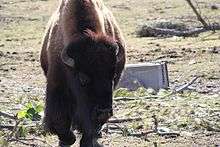
.jpg)
The American Grasslands runs along the southwest border of the zoo, and features fascinating animals from both North and South America, including the Cotton Family Wolf Wilderness, grizzly bears, the Barn, prairie dogs, anteaters, wolverines, bald eagles and Chilean flamingos.
The wilderness habitats of the North American Grasslands are ripe for exploration in an eco-system that includes wildlife from the forest to the prairie. Visitors can experience the large and powerful grizzly bears and black bears in their natural habitats. The majestic bison, which all but disappeared from our country's landscape at one time but were brought back from the brink of extinction, graze peacefully. The Cotton Family Wolf Wilderness is a 2-acre naturalistic habitat that features grassy hills and meadows, native Michigan trees, a flowing stream and pond, dens and elevated rock outcroppings from which wolves can survey their surroundings. Zoo visitors are able to see the wolves from many vantage points around the habitat – including from the historic Log Cabin, which features an observation area with expansive glass viewing windows that allow people to get nose to snout with the wolves. The bald eagles, icons of strength and freedom, can be viewed on the quiet shore of their Pierson Lake habitat. Not far away are the fierce wolverines, the symbol of our great state. A fun immersive feature of the North American Grasslands is the black-tailed prairie dog habitat, where younger visitors can see eye to eye with these small mammals through viewing bubbles.
The South American Grasslands include animals native to the deep rainforests of Colombia and the intrepid coasts of Chile. Giant anteaters can be seen engaging in their unusual method of walking on their knuckles as they hunt for ants and termites. A herd of guanacos – tall mammals that are ancestors of modern llamas – browse on grasses and leaves in a lush habitat they share with the collared peccaries. Visitors can view the largest bird in the Americas, the greater rhea, using its flightless wings to maneuver as it runs on powerfully-adapted legs. The brightly colored Chilean flamingos tend to stay close together in a colony, and visitors can see them proudly display their pink plumage. Nearby, the pair of carnivorous bush dogs can be observed running their carefully mapped paths.
- wolverine
- greater rhea
- guanaco
- collared peccary
- grizzly bear
- giant anteater
- Chilean flamingo
- black bear
- domestic yak
- tree kangaroo
- brown bear
- American bison
- miniature donkey
- bush dog
- Egyptian goose
- horse
- binturong
- prairie dog
- Belted Galloway (cow)
- southern screamer
- gray wolf
- bald eagle
- sheep
- domestic pig
- chicken
- barn owl
Conservation Campus
This section of the zoo includes the famous Penguinarium, National Amphibian Conservation Center, Holden Reptile Conservation Center, Matilda Free Flight Aviary, Butterfly House, Edward Mardigian Sr. River Otter Habitat, Wildlife Interpretive Gallery,
.jpg)
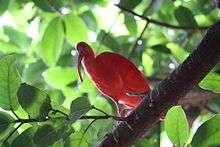
- In the Matilda Wilson Free-Flight Aviary, over 30 species of birds are free to fly, walk, or swim among the cover of lush tropical plants in a warm and inviting climate.
- From the Mexican lance-headed rattlesnake to the Chinese alligator to the McCord's box turtle, the Holden Reptile Conservation Center is home to 240 reptiles representing 80 species, one-fifth of which are considered threatened or endangered in the wild.
- The National Amphibian Conservation Center features more than a thousand fascinating amphibians in spacious, naturalistic exhibits and highlights the critical role these creatures play in the environment. The award-winning facility is home to a spectacular diversity of frogs, toads, salamanders, newts and caecilians.
- The Detroit Zoo's Penguinarium, which opened in 1968, was the first facility in North America designed specifically for penguins. The three-sided habitat is surrounded by a continuous pool which allows the penguins to swim fast enough to porpoise or "fly through the water", a behavior frequently seen in the wild.
- The Edward Mardigian Sr. River Otter Habitat provides a naturalistic environment for our river otters and features an 5,900-gallon pool complete with waterfall and waterslide.
- The beautiful Butterfly Garden can be found inside the Detroit Zoo's Wildlife Interpretive Gallery.
Other highlights
Among other highlights at the Detroit Zoo are the iconic Horace H. Rackham Memorial Fountain, the 2 ft (610 mm) narrow gauge Tauber Family Railroad, the Carousel, and the Ford Education Center which houses the Wild Adventure Ride and the Wild Adventure 3-D/4-D Theater.[34]
- The historic and famed Horace H. Rackham Memorial Fountain, located in the center of the Zoo, was built in 1939 and dedicated to the first president of the Zoological Commission. The fountain features two 10-foot-tall bronze bears in a 75,000-gallon pool with life-sized sea lions, turtles and frogs and is one of the Zoo's most-photographed attractions.
- The Tauber Family Railroad has been a favorite at the Zoo, serving nearly half a million passengers each year since it was presented by The Detroit News in 1931. Since then, nearly half a million passengers have ridden the wonderfully fun miniature railroad each year. The locomotives were refurbished in 2008 with new coaches, rebuilt engines, gears, gauges, wheels and bodies. All aboard! Today's train consists of two complete trains of six coaches each and one standby. All three locomotives were donated by the Chrysler Corp. in the 1950s. In 1982-83, the locomotives were renovated and new coaches were fabricated through a fund-raising campaign by The Detroit Zoological Society and The Detroit News.
- The 36-foot custom-made, wood-and-brass Carousel is adorned with 33 brilliant hand-carved, hand-painted figures, including traditional carousel horses as well as a colorful collection of other mammals, birds, reptiles, amphibians, insects, snakes, fish, seahorses, dinosaurs and an ADA-compliant peacock chariot.
- Science On a Sphere is an amazing spherical display system that projects dynamic simulations of the Earth, its atmosphere, oceans and land. Simply put, it's a global display system that uses computers and video projectors to display planetary data onto a 6-foot diameter sphere, analogous to a giant animated globe.
The Detroit Zoological Society
The Detroit Zoological Society (DZS) is a non-profit organization that operates the Detroit Zoo and Belle Isle Nature Zoo. Its $30 million annual budget is supported by earned revenue, philanthropic support, and a tri-county (Macomb, Oakland, and Wayne) millage. The organization has 210 full and part-time employees, more than 51,000 member households, and more than 1,100 volunteers.[7]
Delivering on its mission of "Celebrating and Saving Wildlife", the DZS is a leader in animal conservation and welfare. In collaboration with the DNR and USFWS, the DZS continues to release Zoo-reared federally endangered Karner blue butterflies in their natural habitats in Michigan with the goal of reestablishing self-sustaining populations. Each summer, DZS bird keepers assist with conservation efforts in northern Michigan for the federally endangered Great Lakes piping plover by artificially incubating abandoned piping plover eggs. Most recently, the DZS, in collaboration with the Detroit River International Wildlife Refuge and the Detroit Water and Sewerage Department, established of a common tern nesting site on Belle Isle.[35]
The Detroit Zoological Society is frequently asked to help with the rescue of exotic animals from private owners, pseudo-sanctuaries, roadside zoos, and circuses. Among the DZS's rescues are more than 1,000 exotic animals confiscated from an animal wholesaler in Texas, a polar bear that was confiscated from a circus in Puerto Rico, a lioness that was used to guard a crack house, and retired racehorses. In addition, the Detroit Zoological Society and Michigan Humane Society, in collaboration with dozens of local animal welfare organizations, host Meet Your Best Friend at the Zoo, the nation's largest offsite companion animal adoption program. Since the event's inception in 1993, more than 17,000 dogs, cats, and rabbits have been placed into new homes at the spring and fall events.[36]
The Center for Zoo Animal Welfare (CZAW) was created in 2009 as a resource center for captive exotic animal welfare knowledge and best practices. It provides a much-needed forum for exotic animal welfare policy discussion/debate and recognizes captive exotic animal welfare initiatives through awards.[37]
The DZS offers education programs year-round for kids, families, youth and scouting groups, classrooms, teachers, and homeschoolers, serving more than 35,000 students annually through education programs and approximately 120,000 more through field trips. In addition, the DZS raises over $170,000 annually to help Peruvian village schools through the Adopt-A-School program. The Berman Academy for Humane Education offers a broad range of unique and engaging programs that help people help animals. The Academy utilizes a variety of teaching strategies – from traditional instruction to storytelling, role-playing, theater, and virtual technology – to educate audiences about the need to treat other living creatures with empathy, respect, and gentleness.[38]
Accredited by the Association of Zoos & Aquariums,[3] the Detroit Zoo features many award-winning exhibits including the Wildlife Interpretive Gallery, National Amphibian Conservation Center, Great Apes of Harambee and Arctic Ring of Life,[7] which was named the number-two best zoo exhibit in the U.S. by the Intrepid Traveler's guide to "America's Best Zoos".
The Wild Adventure Ride is an educational, action-packed thrill ride which offers an exciting you-are-there experience from the comfort of a specially equipped motion-simulated big-screen theater seat. The 126-seat Wild Adventure 3-D/4-D Theater, the only theater of its kind at any Michigan zoo, delivers a high-definition viewing experience in 3-D with 7.1 digital audio surround sound, enhanced with full-sensory 4-D special effects such as blasts of wind, mist and scents.[39]
The Detroit Zoo is located at the intersection of 10 Mile Road and Woodward Avenue in Royal Oak, Mich.[40] It is open daily 9 am to 5 pm April through Labor Day (until 8 pm Wednesdays during July and August), 10 a.m. to 5 pm the day after Labor Day through October and 10 am to 4 pm November through March (closed on Thanksgiving, Christmas and New Year's Day).[41] Admission is $14 for adults 15 to 61, $10 for senior citizens 62 and older, and $10 for children ages 2 to 14; children under 2 are free.[35]
Belle Isle Nature Zoo
The Belle Isle Nature Zoo (BINZ)[42] encompasses approximately 4 acres (1.6 ha) of undisturbed forested wetland on Belle Isle in Detroit, Mich. The Nature Zoo provides year-round educational, recreational and environmental conservation opportunities for the community.
A Deer Encounter, where fallow deer that once roamed the island can be fed by visitors, is part of a multi-phase project to convert the former nature center on Belle Isle into a Nature Zoo focusing on Michigan wildlife, flora and fauna. The Nature Zoo also includes a renovated auditorium, a turtle exhibit featuring native Michigan turtles, an indoor beehive allowing year-round viewing of bee behavior, a spider exhibit and a Creation Station for children's educational programming.[41][43]
Future plans for the Nature Zoo include more nature trails, small mammal exhibits, aquatic life exhibits, a wetland pond and an amphitheater.
CZAW Research
Assessing the Impact of a New, Complex Habitat on the Welfare of Zoo Penguins
Despite their popularity in zoos, penguins have been little studied in the captive environment. The Detroit Zoo is currently constructing the new, state-of-the-art Polk Penguin Conservation Center (PPCC) that will house king, macaroni, rockhopper, and gentoo penguins. The PPCC is being designed to allow for a wide variety of species-appropriate behaviors and for the penguins to exercise greater choice and control. Specifically, a major increase in land space, significantly deeper and greater water space, and more variety of substrates will be available to the penguins. The new habitat will provide a great opportunity to compare the behavior and well-being of the same group of penguins in two drastically different environments. We are currently collecting data for a multi-year study that will examine the behavior of the penguins in each habitat. We are conducting daily observations to gather information on the activity budgets, use of space, and social dynamics of 27 focal penguins. We are also using biologgers to monitor the penguins’ swimming behavior. The data loggers provide an automatic, 24-hour record of the amount of time the penguins spend swimming as well as their preferred swimming depths. Although field researchers have been using these devices for decades, we first conducted a pilot study to confirm that wearing the data loggers had no adverse behavioral effects on the penguins. As this study progresses, we are exploring additional novel measures, such as hormone concentrations in feathers, in order to gain the most complete picture of the penguins’ welfare and how it is affected by their new living space.
Personality in Blanding's Turtles – Implications for Reintroduction Programs
Reintroduction programs involve raising animals in a captive setting, often from birth or hatching, and then releasing them into suitable wild habitat. Personality traits have been linked with survivorship in reintroduced animals. However, much of the research conducted on the success of reintroduction programs has focused on mammalian species. Better understanding the factors that impact survival in herpetological reintroduction programs could improve their success and contribute to the conservation of these ecologically important, but often underappreciated species. For this reason, we measured personality traits in 24 Blanding's turtles prior to release into their natural habitat. The Detroit Zoo collaborates with the U.S. Fish & Wildlife Service to raise turtles hatched at the Zoo and release them into wetland habitat in the Shiawassee National Wildlife Refuge. This process, known as headstarting, is meant to allow individual animals to grow to a certain age or physical size in order to increase chances of survival. The turtles are tracked by investigators from the University of Michigan-Flint for up to two years after release using radio telemetry to assess survival. We are investigating links between dispersal, survival, personality, and habitat type and will use these results in future releases to ensure optimal survival. This will benefit the individual animals by increasing their chances of survival, which in turn will improve the success of this conservation program.
The Impact of Browse Availability on Indicators of Welfare in Western Lowland Gorillas
Gorillas are dedicated herbivores that spend much of their day extracting and processing fibrous plant foods. Opportunities to perform feeding-related behaviors are therefore likely to have a significant impact on the welfare of gorillas in zoos. Increasing the amount of browse, or leafy branches, available to the gorillas may be one way to increase feeding opportunities, but browse can be difficult to obtain in a seasonal environment. The Detroit Zoo recently invested in a freezer for browse to increase the availability of this valuable resource during the winter months. Using frozen mulberry harvested over the previous summer, we investigated the impact of browse availability on feeding-related and social behaviors in the three silverbacks living together as a bachelor group at the Detroit Zoo. We systematically manipulated the amount of browse and alfalfa hay available and measured its effects on the gorillas’ behavior. We also collected fecal and saliva samples to analyze hormonal indicators of welfare. Data analysis indicated that when more browse was available, the gorillas spent more time processing food, displayed less agonistic behavior, and were more active. We also examined fecal glucocorticoid metabolites as a possible measure of stress, as well as C-reactive protein, a salivary biomarker for inflammation. These analyses helped to shed light on the physiological changes accompanying the behavioral differences we observed in relation to browse availability. The results of this investigation will be used to inform the management of the gorillas at the Detroit Zoo and in other zoological parks.
Understanding Social Dynamics and Stress Indicators in Bachelor Gorillas
.jpg)
In the wild, western lowland gorillas (Gorilla gorilla gorilla) most often live in groups of one silverback male, multiple females, and their offspring. Given that gorillas have roughly equal sex ratios at birth, there are numerous captive males for whom female social partners are not available. These males are often housed together in all-male, "bachelor" social groups as an alternative to being housed alone. The Detroit Zoo houses a bachelor group of three silverback gorillas. Using behavioral and hormonal data, we are working to better understand how living in a captive bachelor group impacts each gorilla. Specifically, we investigated how stress levels and social dynamics change depending on whether the gorillas are housed indoors, outdoors, or if they have access to both indoor and outdoor habitats.
Monitoring Habitat Use in Polar Bears
The state-of-the-art Arctic Ring of Life is one of North America's largest polar bear habitats. It allows the bears to experience life on the "pack ice" and the "tundra" as well as life in the water. Behavioral data on the bears in the Arctic Ring of Life is collected to help us understand exactly how the bears use the different features in their habitat. Findings will guide continued improvements of the Arctic Ring of Life.
Assessing Nocturnal Behavior in Captive Giraffes – Implications for Management Decisions

In some species, males and females differ in their behavioral profiles, resulting in the need for different captive management strategies. This study has been designed to determine how and where the giraffes are spending their time at night in order to optimize the welfare of each individual.
Rating Methodology, Personality Axes, and Behavioral Plasticity: A Case Study in African Lions
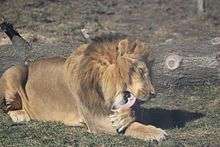
Animal personality is one factor that likely impacts how an animal copes with environmental stressors, such as construction. A case study was undertaken that examined personality in the African lions at the Detroit Zoo and attempted to link personality to stress hormone levels before, during, and after construction of their new habitat. Results are published in the August 2014 issue of the journal Animal Behavior and Cognition.
Simba, a male lion once owned by the royal family of Qatar, found a new palace at the Detroit Zoo. This king of the jungle arrived in the United States from the Middle East in October 2012. Simba enjoys lounging in the grass at the front of the habitat. Erin was rescued from a junkyard in Kansas in 2009. She can sometimes be found playing a game of "soccer" by herself with her favorite toy, the boomer ball. The lions can be seen year-round in their 7,500-square-foot African Grasslands habitat, which features a 17-foot-tall glass wall for a closer view of the big cats. Warming rocks built near the glass provide the lions a toasty perch for people-watching in cooler weather.
Photo gallery
 Barrier free kangaroo exhibit
Barrier free kangaroo exhibit Aviary/butterfly house
Aviary/butterfly house Ring-tailed lemur enjoying its new exhibit
Ring-tailed lemur enjoying its new exhibit Przewalski's wild horse, grazing on fresh grass
Przewalski's wild horse, grazing on fresh grass Davey the binturong
Davey the binturong
See also
Notes
- ↑ "Zoo Facts". Detroit Zoo. Retrieved 2015-02-21.
- ↑ "Detroit Zoo Sets New Attendance Record". Detroit Zoo. Detroit Zoological Society. Retrieved 7 January 2016.
- 1 2 "List of Accredited Zoos and Aquariums". aza.org. AZA. Retrieved December 31, 2010.
- ↑ "Find a Museum Member". aam_us.org. AAM. Retrieved 13 May 2015.
- ↑ "Zoos and Aquariums of the World". waza.org. WAZA. Retrieved 13 May 2015.
- ↑ National Park Service (2010-07-09). "National Register Information System". National Register of Historic Places. National Park Service.
- 1 2 3 4 "Facts About the Detroit Zoo". Retrieved 2012-06-26.
- ↑ "Detroit Zoo Annual Report 2007-2009" (PDF). Retrieved 2012-06-26.
- ↑ Austin, William (1974). The First Fifty Years. Detroit Zoological Society.
- 1 2 Houston, Kay (February 24, 1999). "How the Detroit Zoo's first day was almost its last". detnews.com. Detroit News. Retrieved July 9, 2007.
- ↑ "Wayne County – A Brief History". Archived from the original on August 26, 2007. Retrieved 2007-10-07.
- ↑ "WWJ Newsradio 950 Our Staff". Retrieved 2007-10-07.
- ↑ Wonders Among Us: Celebrating 75 Years of the Detroit Zoo. Royal Oak, MI: Detroit Zoological Society. 2003. p. 91. ISBN 0-615-12418-6.
- ↑ PR NEWS WIRE (October 20, 2001). The World's Largest Polar Bear Exhibit Opens at the Detroit Zoo. United Business Media.
- ↑ Detroit Zoological Society (2001).
- ↑ "Arctic Ring of Life page 1". Archived from the original on June 30, 2007. Retrieved 2007-07-05.
- ↑ "Arctic Ring of Life page 2". Archived from the original on July 8, 2007. Retrieved 2007-07-05.
- ↑ sends its elephants packing. Detroit Zoo. Retrieved on July 9, 2007.
- ↑ Elephants (April 8, 2005).Detroit Free Press.
- ↑ Detroit Zoo Elephant Winky Dies, Detroit Zoo, April 7, 2008.
- ↑ Rhinos. Detroit Zoological Society. Retrieved on July 9, 2007.
- ↑ Outback AdventureDetroit Zoological Society. Retrieved on July 9, 2007.
- 1 2 Polk Penguin Conservation Center http://www.detroitzoo.org/press-releases-2013/10-million-to-support-detroit-zoo-penguin-conservation-center
- ↑ Bat Conservation Center reference http://www.hourdetroit.com/Hour-Detroit/June-2013/A-Really-Cool-Plan/
- ↑ "National Amphibian Conservation Center". Retrieved 2012-06-26.
- 1 2 3 "Exhibit Award". www.AZA.org. Association of Zoos and Aquariums. Retrieved 19 May 2015.
- ↑ "Under the Boardwalk, a World of Wildlife Awaits". www.DetroitZoo.org. Detroit Zoological Society. Retrieved 19 May 2015.
- ↑ "Detroit Zoo Opens Cotton Family Wolf Wilderness". detroitzoo.org. Detroit Zoological Society. Retrieved 24 July 2015.
- ↑ "African Forest". Retrieved 2012-06-26.
- ↑ "The Joy of Six". www.DetroitZoo.org. Detroit Zoo. Retrieved 19 May 2015.
- ↑ "You Otter See What's New at the Detroit Zoo". www.DetroitZoo.org. Detroit Zoo. Retrieved 19 May 2015.
- ↑ "Penguin Conservation Center". www.DetroitZoo.org. Detroit Zoo. Retrieved 19 May 2015.
- ↑ "The Wildlife Interpretive Gallery". Retrieved 2012-06-26.
- ↑ "Attractions". Retrieved 2012-06-26.
- 1 2 "Prices". Retrieved 2012-06-26.
- ↑ "Meet Your Best Friend at the Zoo". Retrieved 2012-06-26.
- ↑ "CZAW". Retrieved 2012-06-26.
- ↑ "Detroit Zoo Education". Retrieved 2012-06-26.
- ↑ "Wild Adventure Ride". Retrieved 2012-06-26.
- ↑ "Directions to the Zoo". Retrieved 2012-06-26.
- 1 2 "Hours". Retrieved 2012-06-26.
- ↑ "About the Belle Isle Nature Zoo". Belle Isle Nature Zoo. Detroit Zoological Society. Retrieved 29 April 2014.
- ↑ "Belle Isle Nature Zoo". Retrieved 2012-06-26.
References and further reading
- Austin, William (1974). The First Fifty Years. The Detroit Zoological Society.
- Detroit Zoological (2003). Wonders Among Us: Celebrating 75 Years of the Detroit Zoo. Detroit Zoological Society. ISBN 0-615-12410-0.
- Fisher, Dale (2003). Building Michigan: A Tribute to Michigan's Construction Industry. Grass Lake, MI: Eyry of the Eagle Publishing. ISBN 1-891143-24-7.
- Rodriguez, Michael and Thomas Featherstone (2003). Detroit's Belle Isle Island Park Gem (Images of America). Arcadia Publishing. ISBN 0-7385-2315-1.
- Kvaran, Einar Einarsson. Shadowing Parducci, unpublished manuscript, Detroit.
External links
| Wikimedia Commons has media related to Detroit Zoo. |
